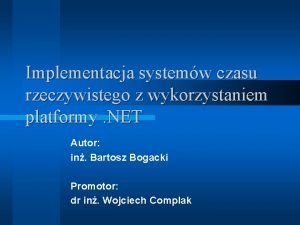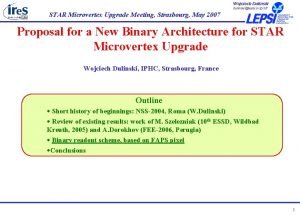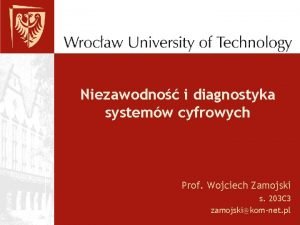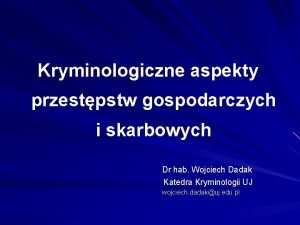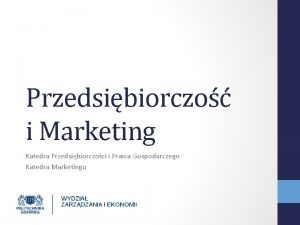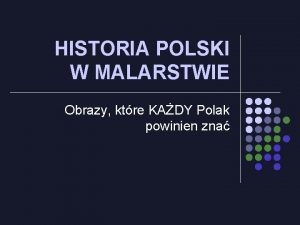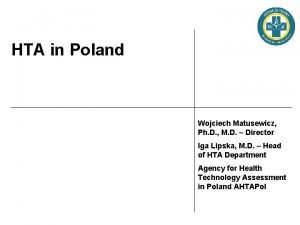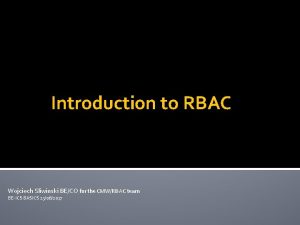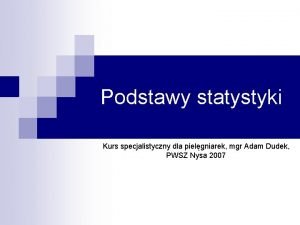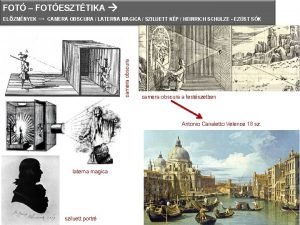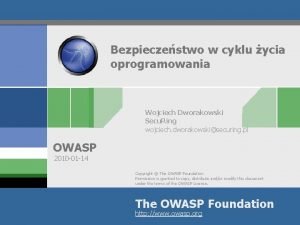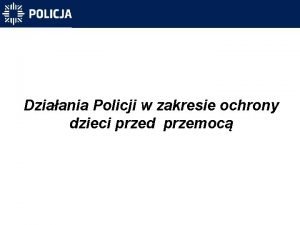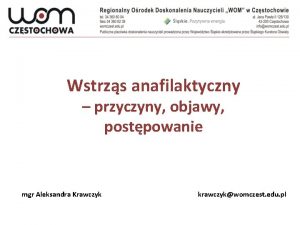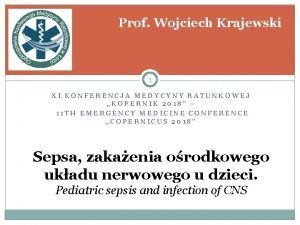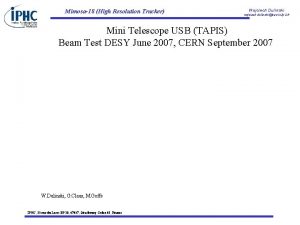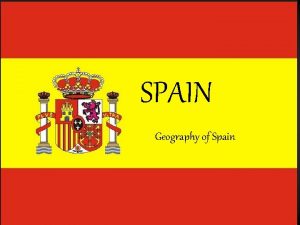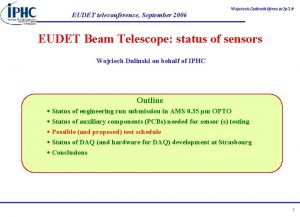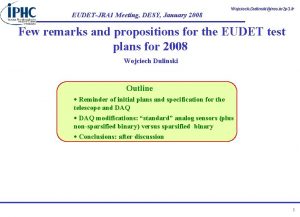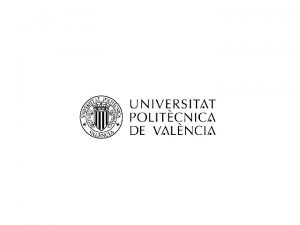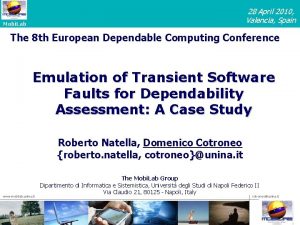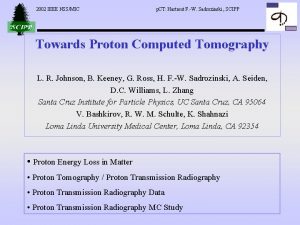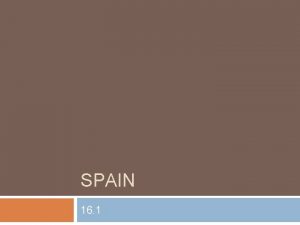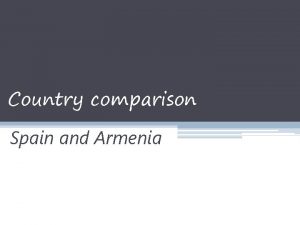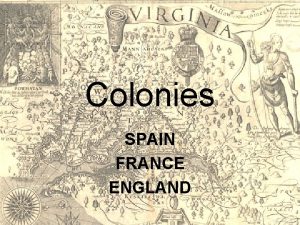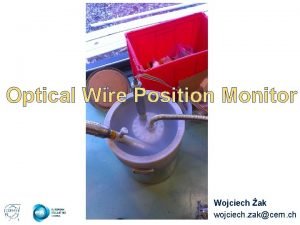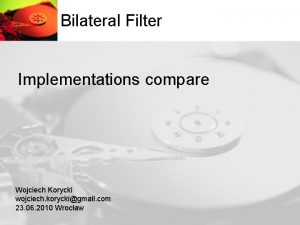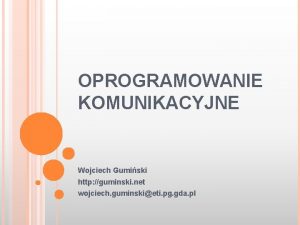IEEE NSSMIC 2011 Valencia Spain Wojciech Dulinskiires in





















- Slides: 21

IEEE NSS-MIC 2011, Valencia, Spain Wojciech. Dulinski@ires. in 2 p 3. fr Large Area Ultra-Thin Detector Ladders based on CMOS Monolithic Pixel Sensors Wojciech Dulinski IPHC Strasbourg, France on behalf of PLUME, SERVIETTE and CERNVIETTE Collaborations Outline · Short status of MAPS development at IPHC · PLUME: the lightweight ladder based on standard flex PCB · SERVIETTE and CERNVIETTE: ultra-thin chip embedding in plastics project (two different process approach) · Conclusions and prospects 1

IEEE NSS-MIC 2011, Valencia, Spain Wojciech. Dulinski@ires. in 2 p 3. fr Monolithic Active Pixel Sensor: effective use of a thin epitaxial layer (10 – 20 µm) for MIP tracking R. T. past present Industrial availability of high resistivity substrate (epi) in a standard CMOS process Fast and more efficient charge collection radiation tolerant MAPS 2

IEEE NSS-MIC 2011, Valencia, Spain Wojciech. Dulinski@ires. in 2 p 3. fr Present status of MAPS: just two examples of mature designs Binary, sparsified readout sensor for EUDET beam telescope > 2 cm 2 active area, 0. 7 Mpixel tracker - Medium speed readout (100 µm integration 10 k. Frame/s) - Spatial resolution < 4 µm for a pitch of 18. 4 µm - Efficiency for MIP > 99. 5 % - Fake hit rate < 10 -6 - Radiation hardness > 1013 n/cm 2 (high resistivity epi substrate) - Easy to use, “off-shell” product: used already in several application Mimosa 26 Ultimate: 4 cm 2 sensor for STAR Microvertex upgrade - similar measured tracking performance as Mimosa 26 - Radiation hardness >1014 n/cm 2 with CMOS MAPS attainable? First indications: yes! 3

IEEE NSS-MIC 2011, Valencia, Spain Wojciech. Dulinski@ires. in 2 p 3. fr One of the main feature of MAPS Potentially extremely thin (~25 µm of silicon in total, ~0. 027 % X 0), flexible (!) and still fully efficient for MIP tracking! Problem: how to handle, interconnect and at the end built a low mass ladder with such a thin device? 4

IEEE NSS-MIC 2011, Valencia, Spain Wojciech. Dulinski@ires. in 2 p 3. fr First real scale exercise: new STAR Microvertex Detector Data taking (1/4 of detector) expected in 2013, full detector installation in 2014 Estimated 0. 37% X 0/ladder. Can we do better? 5

IEEE NSS-MIC 2011, Valencia, Spain Wojciech. Dulinski@ires. in 2 p 3. fr Three RD mini-collaborations initiated by IPHC ~2 years ago, in order to develop new methods of ultra-thin ladders construction PLUME, SERVIETTE and CERNVIETTE Collaborations 1 IPHC/IN 2 P 3 Strasbourg, France 5 University of Bristol, UK 6 DESY, Hamburg, Germany 7 University of Oxford, UK 2 IMEC, Leuven, Belgium 3 CMST, University of Gent, Belgium 4 IFK, Goethe University, Frankfurt/M, Germany 8 CERN, Geneva 6

IEEE NSS-MIC 2011, Valencia, Spain Wojciech. Dulinski@ires. in 2 p 3. fr PLUME concept: double-sided ladder (ILC compatible) - 2 x 6 Mimosa 26 sensors thinned down to 50 µm - Standard double-side kapton PCB: Cu conductor (20 µm/layer) - Si. C foam (8%) for spacer between layers - Estimated 0. 6 % X 0/two sensor layers 7

IEEE NSS-MIC 2011, Valencia, Spain Wojciech. Dulinski@ires. in 2 p 3. fr PLUME prototype: assembling steps bare low mass cable module with 6 sensors complete ladder (2 modules) 8

IEEE NSS-MIC 2011, Valencia, Spain Wojciech. Dulinski@ires. in 2 p 3. fr Heat dissipation: moderate air blow seems to solve a lot of “hot spots” problems Electrical parameters (threshold dispersion, fake hit rate) almost unchanged… 9

IEEE NSS-MIC 2011, Valencia, Spain Wojciech. Dulinski@ires. in 2 p 3. fr Current status of PLUME prototype: ready for beam tests next week! 10

IEEE NSS-MIC 2011, Valencia, Spain Wojciech. Dulinski@ires. in 2 p 3. fr SERVIETTE project: use of UTCP by IMEC… § Stands for : ULTRA THIN FILM CHIP PACKAGING § In short : Ø Off-the-shelf die Ø Thinned down to ± 20 -30 µm Polyimide 2 Ø Packaged between two polyimide foils Ø Metallisation : fan-out Ø Circuit contact through vias Polyimide 1 § Result : Ø Flexible package, no wire bonding Ø Thin : 50 -70 µm Ø Embeddable in commercial flexible PCB - Partner restricted PTW Oct. 2010 - HUMAN++ 11

IEEE NSS-MIC 2011, Valencia, Spain Wojciech. Dulinski@ires. in 2 p 3. fr UTCP flow: overview • Polyimide on rigid carrier with release layer (KCl) • Chip thinning • Dispense/spin of BCB • Placement (face up) of IC 60 mm • Photo definable polyimide spinning (20µm)) • Opening vias using lithography • Cleaning of contact pads • Metallization: Ti. W (50 nm) + Cu(1µm) • Electroplating : Cu (5µm) • Lithography to pattern metal • Encapsulation polyimide spinning • Release from carrier 12

IEEE NSS-MIC 2011, Valencia, Spain Wojciech. Dulinski@ires. in 2 p 3. fr First results: Mimosa 18 mechanical grade sample Submitted for fabrication more than a year ago, very slow progress since, on stand-by till thinned chip placement problems solved. Aluminum conductor, multiple metal layers and multiple chips still far ahead… 13

IEEE NSS-MIC 2011, Valencia, Spain Wojciech. Dulinski@ires. in 2 p 3. fr CERNVIETTE: use of a “standard” flex PCB process for chip embedding in plastic foils (Rui de Oliveira, Serge Ferry) • Gluing between two kapton foils • Opening vias using lithography • Single module: intermediate tests • Metallization: Al (5 -10 µm) • Lithography to pattern metal • Complete ladder assembling, laser cut along sensor edges • Gluing of another kapton foil for deposition of second metal layer 14 14

Wojciech. Dulinski@ires. in 2 p 3. fr IEEE NSS-MIC 2011, Valencia, Spain CERNVIETTE: stack formation Copper 150 µm Polyimide Silicon chip Acrylic glue Polyimide Acrylic glue Copper substrate 1. 5 mm Thin layer of epoxy glue 3 to 10 µm acrylic glue 60 µm

IEEE NSS-MIC 2011, Valencia, Spain Wojciech. Dulinski@ires. in 2 p 3. fr CERNVIETTE: processing steps 1 -Gluing at 200 deg, 22 kg/cm 2 under vacuum 2 -Photolithographic method and chemical etching by ethylene diamine to create vias on top of bonding pads 3 -Plasma etching of glue in vias 4 -Aluminium coating by sputtering deposition in vacuum machine 16

IEEE NSS-MIC 2011, Valencia, Spain Wojciech. Dulinski@ires. in 2 p 3. fr CERNVIETTE: processing steps 5 -Photolithographic method and etching with phosphoric acid to pattern aluminium layer (strip, pads). Step 1 to 5 can be repeated to create more metal layers and interconnexions 6 -Chemical Etching of copper substrate 17

IEEE NSS-MIC 2011, Valencia, Spain Wojciech. Dulinski@ires. in 2 p 3. fr CERNVIETTE: solid state flexible sensor wrapped over cylindrical shape (R=20 mm) and pretty well protected 18

IEEE NSS-MIC 2011, Valencia, Spain Wojciech. Dulinski@ires. in 2 p 3. fr Major failure: too short plasma etching of glue layer, no electrical contacts… But excellent metal adhesion and thickness uniformity! Second (corrected) iteration expected to be ready next week 19

IEEE NSS-MIC 2011, Valencia, Spain Wojciech. Dulinski@ires. in 2 p 3. fr CERNVIETTE: details of 4 metal layer flex (~0. 12% X 0) Impedance of readout lines (last metal, 100 µm width, 100 µm gap) as a function of kapton thickness: 100 Ω for 60 µm thick kapton (last layer) 20

IEEE NSS-MIC 2011, Valencia, Spain Wojciech. Dulinski@ires. in 2 p 3. fr Conclusions - Construction methods of ultra-light sensor ladders are progressing rapidly, embedding in polymer seems to be a new interesting option - It is at present our preferred solution in order to take full profit from MAPS high precision tracking performances AND to equip with a reasonable budget large area detectors (replacement of silicon strips, tracking calorimeters…) Outlook - Double-sided PLUME module (0. 6 % X 0) fully operational, ready for beam tests starting next month. The next version (Al instead of Cu conductor, less dense Si. C foam 0. 3 % X 0) in 2012 - Second iteration of single Mimosa 26 embedded in kapton (CERNVIETTE) next week, full PLUME compatible ladder (six M 26) planned for beginning of the next year - CERNVIETTE process may by much less critical, if the last metal layer on the chip is used for better (less dense) “bonding pads” distribution 7 metal CIS 0. 18 µm process available! - Start to think about stitching exercise: wafer scale, up to 10 x 10 cm 2 monolithic sensor possible 21
 Inheritance tax valencia region spain
Inheritance tax valencia region spain Wojciech complak
Wojciech complak Wojciech duliński
Wojciech duliński Wojciech zamojski
Wojciech zamojski Wojciech dadak nie żyje
Wojciech dadak nie żyje Wojciech wyrzykowski pg
Wojciech wyrzykowski pg Wojciech szpankowski
Wojciech szpankowski Wigilia na syberii malczewski
Wigilia na syberii malczewski Ahtapol
Ahtapol Wojciech dworakowski
Wojciech dworakowski Wojciech sliwinski
Wojciech sliwinski Silverlight 5 download
Silverlight 5 download Wojciech wencel
Wojciech wencel Wojciech szpankowski
Wojciech szpankowski Wojciech korfanty
Wojciech korfanty Wojciech dworakowski
Wojciech dworakowski Wojciech rodek
Wojciech rodek Aleksandra krawczyk
Aleksandra krawczyk Prof. wojciech krajewski
Prof. wojciech krajewski Wojciech weiss japonka
Wojciech weiss japonka Wojciech lubas
Wojciech lubas Ewald gawlik
Ewald gawlik

